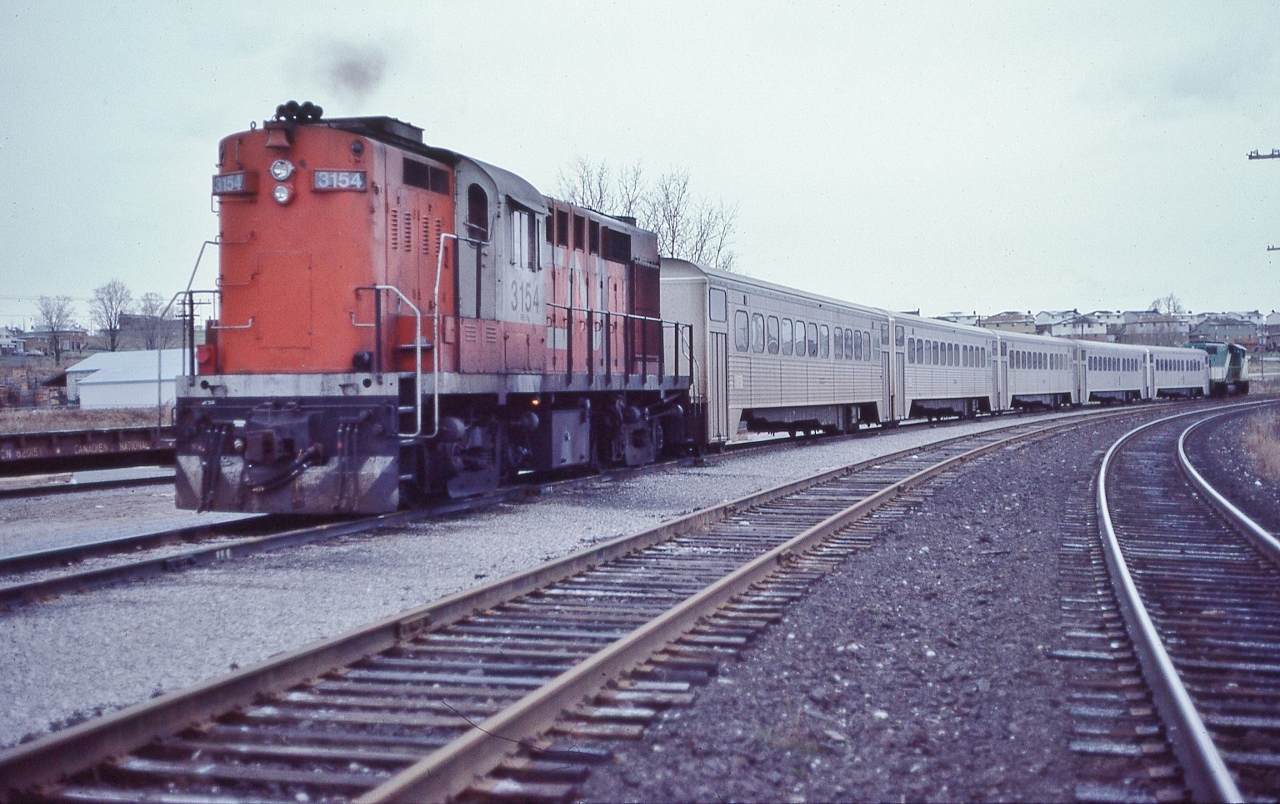|
Caption:
For reasons that defy logic – by today's standards – early VIA decided the Tempo equipment (built circa 1968),
did not suit the needs, despite being the newest (after the Turbos) equipment in the fleet VIA inherited (actually you & I bought from CN),and being head end powered (electrical heat & air);
and that explains how Tempo units – owned by CN and not bought by VIA – became available when GO was short ACPU units
About the time this Kodachrome was exposed GO was in the process (actual the ONR shops) of rebuilding the two ex MILW F's ( #93A & #104A) into the future GO #910 (rebuilt 1981) & 911 (rebuilt 1982).
MILW 103A
At Bradford,a GO 700 series unit powers a northbound GO, with CN Tempo #3151 providing the HEP, on what must be a re-positioning move on Sunday Nov 14, 1982 Kodachrome by J. Art Clowes collection of S.Danko,
Interesting
Bradford GO train service commenced September 7, 1982.
And all the (steam heated) equipment VIA employed to replace the Tempo Trains is long retired, sold or scrapped and the Tempo Train equipment, after a couple of decades owned by the D&RGW for their Ski Train, is back on CN rails (now Watco) as the Agawa Canyon train.
|



I’ve always felt this move didn’t make complete sense – but there’s another layer to it.
The RS-18M units were surplus at this point because over the course of 1982, VIA converted the Tempo cars from 575V electrical systems (which matched GO equipment) to 480V electrical systems (which matched Amtrak’s HEP and the new LRC electrical systems). The restored “International” to Chicago started running on October 31, 1982 (the day after the last Turbo run – but that’s unrelated) and the first train was an LRC locomotive and four Tempo cars. For a few years, Amtrak and VIA equipment could be found mixed on this service.
Regardless, Tempo cars could now be powered by new LRC units, so there was no need to convert the HEP generators on the RS-18M units – but they still matched the GO fleet. (Before this, trades could happen two ways, and occasionally a GP40TC hauled a Tempo to Windsor.)
At the same time, GO picked up two services as VIA dropped them. The VIA “Barrie Bullet” commuter train (which had been “balloon top” coaches and whatever passenger-geared locomotive was available) became GO’s Bradford service, and the GO Stouffville service replaced a VIA service held down by RDCs. Both VIA services were cancelled as a result of the November 1981 cutbacks, but then given an extra year to give GO time to take over. (A third commuter-esque service, VIA to Peterborough, was also extended into late 1982, but not picked up by GO. It disappeared completely until it was restored in June 1985, only to be cut again in January 1990.)
So GO used these units to bridge a HEP gap while the ex-MILW units became ACPUs, as you mention. This was followed by more new and new-ish equipment, the ex-RI GP40 units and the second order of bilevel cars, which started arriving in 1983 (and with cab cars this time).
But back to VIA – not only did they ditch their second-newest and already-HEP rolling stock in 1987/1988, they did this after paying to upgrade the electrical systems only a few years prior. THEN (it keeps going) they refurbished the ex-Amtrack LRC equipment as the VIA contribution to the “International” service. This included two cafe cars – the only two LRC service cars – that more-or-less matched the Amfleet “AmCafe” configuration, providing a more standardized experience on that train, regardless of which railroad supplied the consist. Yet another set or relatively new, HEP-equipped passenger cars… but these were only used until 1994, when they were withdrawn… after which, Amtrak supplied all of the passenger cars for the International. (VIA kept supplying F40s for a few more years, but by the end in 2003-2004 the train was 100% furnished by Amtrak.)
Anyway (did you think this was over?), what did VIA do in 1994? Roll those 1980-built, 1988-refurbished cars into their LRC fleet? No… they bought a hodgepodge of old stainless steel coaches – some dating from the 1940s – and converted them to HEP, creating the HEP2 fleet we still have today.
Meanwhile, two 1954-vintage steam-heated consists held down SW Ontario assignments until 1996. The HEP2 fleet allowed these to finally retire. The HEP2 fleet is 35 cars. The Tempo fleet (1967-1987) was 25 cars. The ex-Amtrak LRC fleet (1980/1988-1994) was 12 cars.
So… defying logic? Yeah. Your mileage may vary, but my math ain’t mathing.